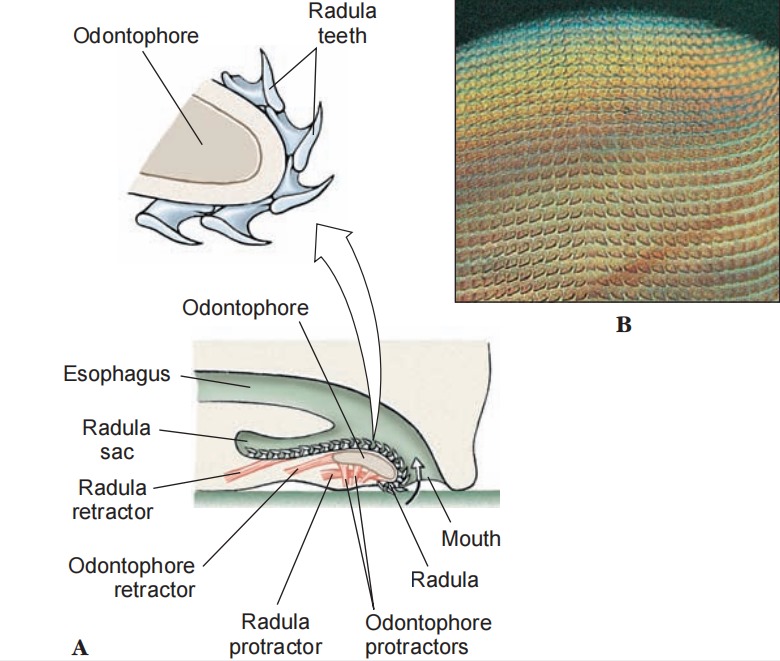The enormous variety, great beauty, and easy availability of shells of molluscs have made shell collecting a popular pastime. However, many amateur shell collectors, even though able to nameh undreds of the shells that grace our beaches, know very little about the living animals that created those shells and once lived in them. Reduced to its simplest dimensions, the mollusc body plan may be said to consist of a head–foot portion and a visceral mass portion. The head-foot is the more active area, containing the feeding, cephalic sensory, and locomotor organs. It depends primarily on muscular action for its function.

The visceral mass is the portion containing digestive, circulatory, respiratory,and reproductive organs, and it depends primarily on ciliary tractsfor its functioning. Two folds of skin, outgrowths of the dorsal body wall, form a protective mantle, which encloses a space between the mantle and body wall called the mantle cavity. The mantle cavity houses gills (ctenidia) or a lung, and in some molluscs the mantle secretes a protective shell over the visceral mass. Modifications of the structures that make up the head-foot and the visceral mass produce the great diversity of patterns observed in Mollusca. Greater emphasis on either the head-foot portion or the visceral mass portion can be observed in various classes of molluscs.
Most molluscs have well-developed heads, which bear their mouth and some specialized sensory organs. Photosensory receptors range from fairly simple ones to the complex eyes of cephalopods. Tentacles are often present. Within the mouth is a structure unique to molluscs, the radula, and usually posterior to the mouth is the chief locomotor organ, or foot.
The radula is a rasping, protrusible, tonguelike organ found in all molluscs except bivalves and most solenogasters. It is used for feeding and consists of a ribbonlike membrane on which are mounted rows of tiny teeth that point backward. Complex muscles move the radula and its supporting cartilages (odontophore) in and out of the mouth while the membrane is partly rotated over the tips of the cartilages. There may be a few or as many as 250,000 teeth, which, when protruded, can scrape, pierce, tear, or cut.

The usual function of the radula is twofold: to rasp fine particles of food material from hard surfaces and to serve as a conveyor belt for carrying particles in a continuous stream toward the digestive tract. As the radula wears away anteriorly, new rows of teeth are continuously replaced by secretion at its posterior end. The pattern and number of teeth in a row are specific for each species and are used in the classification of molluscs. Very interesting radular specializations, such as for boring through hard materials or for harpooning prey, are found in some forms.
The molluscan foot may be variously adapted for locomotion, for attachment to a substratum, or for a combination of functions. It is usually a ventral, solelike structure in which waves of muscular contraction effect a creeping locomotion. However, there are many modifications, such as the attachment disc of limpets, the molluscs that glide on cilia.
In snails and bivalves the foot is extended from the body hydraulically, by engorgement with blood. Burrowing forms can extend the foot into the mud or sand, enlarge it with blood pressure, then use the engorged foot as an anchor to draw the body for- ward. In pelagic (free-swimming) forms the foot may be modified into winglike parapodia, or thin, mobile fins for swimming.
The mantle is a sheath of skin, extending from the visceral mass, that hangs down on each side of the body, protecting the soft parts and creating between itself and the visceral mass a space called the mantle cavity. The outer surface of the mantle secretes the shell. The mantle cavity plays an enormous role in the life of a mollusc. It usually houses respiratory organs (gills or lung), which develop from the mantle, and the mantle’s own exposed surface serves also for gaseous exchange. Products from the digestive, excretory, and reproductive systems are emptied into the mantle cavity. In aquatic molluscs a continuous current of water, kept moving by surface cilia or by muscular pumping, brings in oxygen and, in some forms, food.
This same water current also flushes out wastes and carries reproductive products out to the environment. In aquatic forms the mantle is usually equipped with sensory receptors for sampling environmental water. In cephalopods (squids and octopuses) the muscular mantle and its cavity create jet propulsion used in locomotion. Many molluscs can withdraw their head or foot into the mantle cavity, which is surrounded by the shell, for protection.
In the simplest form, a mollusc ctenidium (gill) consists of a long, flattened axis extending from the wall of the mantle cavity. Many leaflike gill filaments project from the central axis. Water is propelled by cilia between gill filaments, and blood diffuses from an afferent vessel in the central axis through the filament to an efferent vessel. Direction of blood movement is opposite to the direction of water movement, thus establishing a countercurrent exchange mechanism. The two ctenidia are located on opposite sides of the mantle cavity and are arranged so that the cavity is functionally divided into an incurrent chamber and an excurrent chamber. The basic arrangement of gills is variously modified in many molluscs.

The shell of a mollusc, when present, is secreted by the mantle and is lined by it. Typically there are three layers. The periostracum is the outer organic layer, composed of an organic substance called conchiolin, which consists of quinonetanned protein. It helps to protect underlying calcareous layers from erosion by boring organisms. It is secreted by a fold of the mantle edge, and growth occurs only at the margin of the shell. On the older parts of the shell, periostracum often becomes worn away.

The middle prismatic layer is composed of densely packed prisms of calcium carbonate (either aragonite or calcite) laid down in a protein matrix. It is secreted by the glandular margin of the mantle, and increase in shell size occurs at the shell margin as the animal grows. The inner nacreous layer of the shell lies next to the mantle and is secreted continuously by the mantle surface, so that it increases in thickness during the life of the animal. The calcareous nacre is laid down in thin layers. Very thin and wavy layers produce the iridescent mother-of-pearl found in abalones (Haliotis), chambered nautiluses (Nautilus), and many bivalves. Such shells may have 450 to 5000 fine parallel layers of crystalline calcium carbonate for each centimeter of thickness.
There is great variation in shell structure among molluscs. Freshwater molluscs usually have a thick periostracum that gives some protection against acids produced in the water by decay of leaf litter. In many marine molluscs the periostracum is relatively thin, and in some it is absent. Calcium for the shell comes from environmental water or soil or from food. The first shell appears during the larval period and grows continuously throughout life.
Gas exchange occurs in specialized respiratory organs such as ctenidia, secondary gills and lungs, as well as the body surface, particularly the mantle. There is an open circulatory system with a pumping heart, blood vessels, and blood sinuses. In an open circulatory system blood is not entirely contained within blood vessels; rather it flows through vessels in some parts of the body and enters open sinuses in other parts. An open circulatory system is less efficient at supplying oxygen to all tissues in the body, so it is common in slow-moving animals. Insects are a notable exception, but in these animals oxygen is distributed by the tracheal system, not by the circulatory system. In a closed circulatory system, blood moves to and from tissues within blood vessels. Most cephalopods have a closed circulatory system with heart, vessels, and capillaries.
The digestive tract is complex and highly specialized, according to feeding habits of the various molluscs, and is usually equipped with extensive ciliary tracts. Most molluscs have a pair of kidneys ( metanephridia, a type of nephridium in which the inner end opens into the coelom by a nephrostome). Ducts of the kidneys in many forms also serve for discharge of eggs and sperm.
The nervous system consists of several pairs of ganglia with connecting nerve cords, and it is generally simpler than that of annelids and arthropods. The nervous system contains neurosecretory cells that, at least in certain air-breathing snails, produce a growth hormone and function in osmoregulation. There are various types of highly specialized sense organs.
Useful External Links



